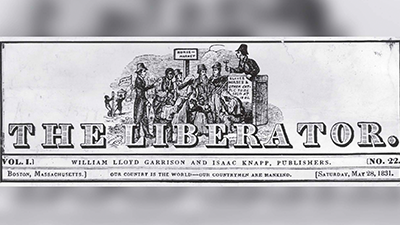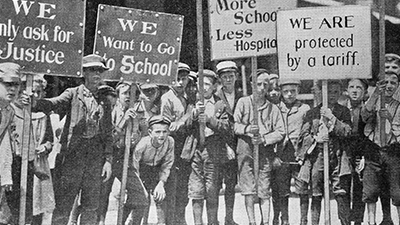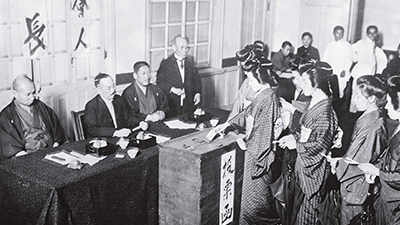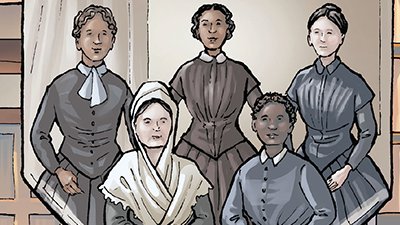Reform Movements
Teacher Resources
Driving Question: How did industrialization lead to calls for reform?
Industrialization reshaped lives and raised new questions about equality and human rights. In this lesson, you’ll explore how people around the world responded through reform movements like abolition, child labor laws, and women’s suffrage. You’ll also consider how individuals played powerful roles in demanding change.
Learning Objectives:
- Use the historical thinking process of sourcing to examine the causes for the abolition of slavery.
- Utilize comparison skills to examine how women’s reform movements developed in different regions and addressed issues of rights and representation.
- Use a graphic biography to support, extend, or challenge the overarching narratives of this period.
Vocab Terms:
- abolitionism
- enslavement
- evangelical
- legislation
- moral
- profit
- suffrage
Opener: Reform Movements
To teach this lesson step, refer to page 2 of the Lesson 7.8 Teaching Guide.
Looking for a refresher on reading comics? Dr. Trevor Getz provides a helpful approach in the How to Read Comics activity.
Dive into the complex story of abolition by focusing on Harriet Forten Purvis, a lesser-known but powerful activist. Using visual evidence and historical clues, you’ll piece together her story and start to explore how individuals helped shape global movements for freedom.
Abolition
To teach this lesson step, refer to page 3 of the Lesson 7.8 Teaching Guide.
These materials explore why slavery was abolished and highlight the role of abolitionist voices. You’ll use evidence to understand how abolition reshaped politics and the economy in the industrial age.
-
Guiding Questions
-
Before you read
Preview the questions below, and then skim the article. Be sure to look at the section headings and any images.
While you read
Look for answers to these questions:
- Which countries ended the slave trade or slavery early—and which ended it late?
- How did capitalism and industrialization help bring slavery to an end?
- How did changing beliefs about morality and human rights help end slavery?
- How did African and African-descended communities work to end slavery?
- Did slavery really end when it became illegal?
After you read
Respond to this question: Which argument for why slavery ended do you find most convincing, and why?
Child Labor
To teach this lesson step, refer to page 8 of the Lesson 7.8 Teaching Guide.
Check out our Reading Guide to learn about the Three-Step Reading approach.
These materials will help you understand how child labor fit into the world of the Industrial Revolution, and how reformers began to push for change.
-
Guiding Questions
-
Before you read
Preview the questions below, and then skim the article. Be sure to look at the section headings and any images.
While you read
Look for answers to these questions:
- How did ideas about childhood change during this time?
- What are the limitations of using Matthew Crabtree’s account as evidence?
- What economic factors helped make child labor laws more effective?
- How did children’s work change over time in industrialized societies?
After you read
Respond to these questions: Are labor conditions better today than they were 100 years ago? If so, for whom, and how can we tell?
Women’s Suffrage
To teach this lesson step, refer to page 9 of the Lesson 7.8 Teaching Guide.
Review the Origins Practice Progression Placemat to discover where else your students will engage in historical comparison after the long Nineteenth Century.
Explore how the fight for women’s voting rights took shape in different countries. You’ll compare movements to see how context shaped their goals and outcomes.
-
Guiding Questions
-
Before you read
Preview the questions below, and then skim the article. Be sure to look at the section headings and any images.
While you read
Look for answers to these questions:
- What is suffrage?
- Where did the women’s suffrage movement begin in New Zealand?
- Why did women in the UK gain the right to vote in 1929?
- Why did suffrage in India develop slowly under British rule?
- Who was excluded from voting in North America before the 1960s?
After you read
Respond to this question: How do you think gaining the right to vote changed life for women in different parts of the world?
Closer: Reform Movements
To teach this lesson step, refer to page 11 of the Lesson 7.8 Teaching Guide.
Dig deeper into Harriet Forten Purvis’s biography to find evidence of how morals, economics, and activism shaped her fight for abolition—and decide which one mattered most to her mission.
Writing: Industrialization Impacts
To teach this lesson step, refer to page 11 of the Lesson 7.8 Teaching Guide.
In this writing activity, you’ll use evidence from sources to support an argument that responds to the question: How did industrialization impact society during the long nineteenth century?
Child Labor Reforms
To teach this lesson step, refer to page 12 of the Lesson 7.8 Teaching Guide.
This simulation offers a vivid picture of industrial child labor in nineteenth-century Britain.









